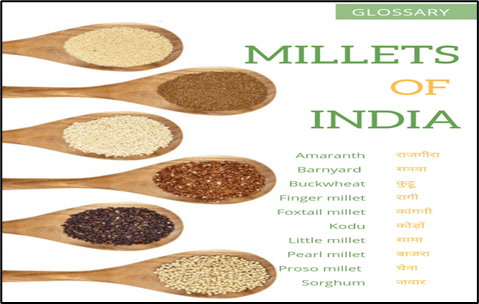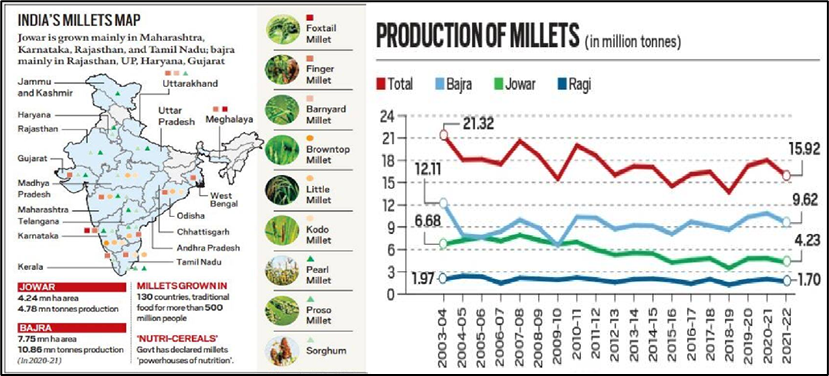Why in News?
- Recently, the United Nations General Assembly (UNGA) declared 2023 as the International Year of Millets (IYM), a proposal sponsored by the Government of India to promote these "nutri-cereals."
- The declaration will be helpful to the Government of India in articulating its goal of making IYM 2023 a "People's Movement" as well as presenting India as the "Global Hub for Millets," as India produces one-fifth of the world's millets.
What’s in today’s article:
- What are Millets?
- Status of millets in India
- Where do millet lag?
- Steps taken in India to promote millets:
- Way ahead for India
- Conclusion
What are Millets?

- Millets are a highly varied group of small-seeded grasses, widely grown around the world as cereal crops or grains for fodder and human food.
- They are important crops in the semiarid tropics of Asia and Africa (especially in India, Mali, Nigeria, and Niger), with 97% of millet production in developing countries.
- This crop is favoured due to its productivity and short growing season under dry, high-temperature conditions (hardy and drought-resistant crops).
- Millets are a powerhouse of nutrients, which score over rice and wheat in terms of minerals, vitamins, and dietary fibre content, as well as amino acid profile.
- Though rich in both iron and zinc, wheat’s protein content comprises glutens, known to trigger gastrointestinal and autoimmune disorders in many people.
- Bajra (pearl millet), on the other hand, has iron, zinc, and protein levels comparable to that of wheat, but it’s gluten-free and has more fibre and which significantly addresses the problem of “hidden hunger.”
Status of millets in India:

- They were among the first crops to be domesticated in India with several evidence of its consumption during the Indus valley civilization.
- In India, millets are primarily a kharif crop, requiring less water and agricultural inputs than other similar staples.
- The main millet-growing states in India are Rajasthan, Maharashtra, Karnataka, Andhra Pradesh, and Madhya Pradesh
Where do millets lag?
- Rice and wheat no longer remain aspirational foods. Thanks to the Green Revolution and the National Food Security Act of 2013.
- Millets are not the first choice either of consumers or of farmers.
- For farmers, low per-hectare yields (1 tonne for jowar, 1.5 for bajra and 1.7 for ragi, as against 3.5 tonnes for wheat and 4 tonnes for paddy) are a disincentive.
- Also, access to assured irrigation, made farmers switch to rice, wheat, sugarcane, or cotton.
- For consumers, the gluten proteins make the wheat dough more cohesive and elastic and the resultant breads come out light and fluffy, which isn’t the case with bajra or jowar.
Steps taken in India to promote millets:
- Pusa-1201: A hybrid bajra that gives an average grain yield of over 2.8 tonnes and potential of 4.5 tonnes per hectare.
- It matures in 78-80 days and is resistant to downy mildew and blast, both deadly fungal diseases.
- Recognising the enormous potential of Millets, which also aligns with several UN Sustainable Development Goals (SDGs), the Government of India (in 2018),
- Rebranded Millets as “Nutri Cereals”
- Declared 2018 as the National Year of Millets, aiming at larger promotion and demand generation
Way ahead for India:
- Millets could be made a staple part of children’s diets:
- Pradhan Mantri Poshan Shakti Nirman and Saksham Anganwadi and Poshan 2.0 can be better leveraged by making them more millet-focused.
- Besides midday meals, millets could be served in the form of ready-to-eat foods such as cookies, laddu, etc.
- Minimum support price (MSP) procurement of millets should be part of a decentralised nutritional programme specifically targeting tomorrow’s citizens.
- The push to distribute coarse grains under the public distribution system (PDS) has to gain momentum.
- Best practice: Odisha already has a dedicated millet mission that undertook procurement of 32,302 tonnes worth Rs 109.08 crore, mainly of ragi, in 2021-22.
Conclusion:
- A combination of government finance and decentralised procurement connected to nutrition goals, specifically the eradication of hidden hunger among school-age children, has the potential to do for millets what the Food Corporation of India has done for rice and wheat.










